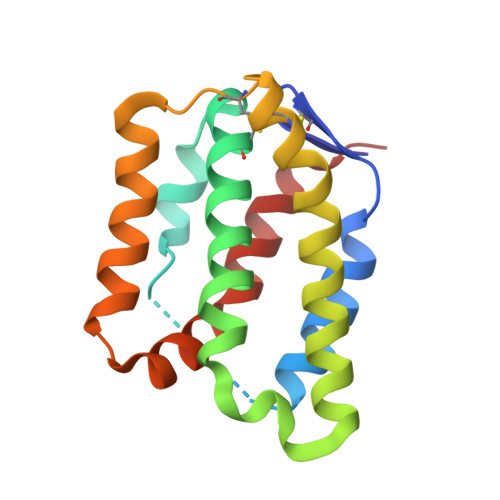Flexible regions govern promiscuous binding of IL-24 to receptors IL-20R1 and IL-22R1.
Zahradnik, J., Kolarova, L., Peleg, Y., Kolenko, P., Svidenska, S., Charnavets, T., Unger, T., Sussman, J.L., Schneider, B.(2019) FEBS J 286: 3858-3873
- PubMed: 31152679
- DOI: https://doi.org/10.1111/febs.14945
- Primary Citation of Related Structures:
6GG1 - PubMed Abstract:
Interleukin 24 (IL-24) is a cytokine with the potential to be an effective treatment for autoimmune diseases and cancer. However, its instability and difficulties in its production have hampered detailed biological and biophysical studies. We approached the challenges of IL-24 production by using the PROSS algorithm to design more stable variants of IL-24. We used homology models built from the sequences and known structures of IL-20 and IL-19 and predicted and produced several extensively mutated IL-24 variants that were highly stable and produced in large yields; one of them was crystallized (IL-24B, PDB ID 6GG1; 3D Interactive at http://proteopedia.org/w/Journal: FEBS_Journal:1). The mutated variants, however, lost most of their binding capacity to the extracellular parts of cognate receptors. While the affinity to the receptor 2 (IL-20R2) was preserved, the variants lost affinity to IL-20R1 and IL-22R1 (shared receptors 1). Back engineering of the variants revealed that reintroduction of a single IL-24 wild-type residue (T198) to the patch interacting with receptors 1 restored 80% of the binding affinity and signaling capacity, accompanied by an acceptable drop in the protein stability by 9 °C. Multiple sequence alignment explains the stabilizing effect of the mutated residues in the IL-24 variants by their presence in the related and more stable cytokines IL-20 and IL-19. Our homology-based approach can enhance existing methods for protein engineering and represents a viable alternative to study and produce difficult proteins for which only in silico structural information is available, estimated as >40% of all important drug targets.
Organizational Affiliation:
Institute of Biotechnology of the Czech Academy of Sciences, BIOCEV, Vestec, Czech Republic.
















